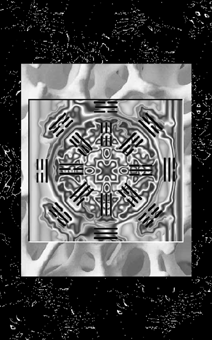|
|
Knight
... 1000 eyes Cover
On Blending Fact
/ Fiction
Frontis
Art of 3 Sections
Tai Chi
as Language(1)
Synchronicity
Hexagram ...
Chinese Dream Character
Taoist Magic Square
Spiritual Intelligence
Of
Ideogramatic Paintings
Cultivating the Texas Twister Hybrid
The Secret of the Cicada'sSong
Knight of a 1000 eyes
Dolores
Park
A Blue Moon in August
Thoughts on Vacation
|
Frontis Art for three sections: Knight of a 1000
eyes
|
 The time of the book Knight of a 1000 eyes
spans 30 minutes or so, the time required to
perform the 108 movement Yang Style Tai Chi Long
Form. The book has 108 chapters, some named with
the precise number and name of the move. We are
observing the mind of the performer, sometimes it
is focused on the move, sometimes it is in
meditation or feeling, sometimes it is caught up in
the Tao. Concurrent, simultaneous, the time of the
book is the history of the Tai Chi student as he
progresses from Beginner to Journeyman to Master.
These levels are called Frames, The first level is
Fixed Frame.
The time of the book Knight of a 1000 eyes
spans 30 minutes or so, the time required to
perform the 108 movement Yang Style Tai Chi Long
Form. The book has 108 chapters, some named with
the precise number and name of the move. We are
observing the mind of the performer, sometimes it
is focused on the move, sometimes it is in
meditation or feeling, sometimes it is caught up in
the Tao. Concurrent, simultaneous, the time of the
book is the history of the Tai Chi student as he
progresses from Beginner to Journeyman to Master.
These levels are called Frames, The first level is
Fixed Frame.
|
|
 The second section of the book Knight of a 1000
eyes takes the player into a much higher level
of mechanical sophistication. The notion of Lively
frame has to do with the Tai Chi player becoming
more attuned to his body, and since he already
knows the form, he can play with it, relax into it.
.
The second section of the book Knight of a 1000
eyes takes the player into a much higher level
of mechanical sophistication. The notion of Lively
frame has to do with the Tai Chi player becoming
more attuned to his body, and since he already
knows the form, he can play with it, relax into it.
.
The image for this section has the yin yang symbol
become more prominent, but is is still hiding
behind the image of the fractal, which is par
excellence the modern understanding of Chaos and
the Tao, The image says, that at the same time that
we are become more accomplished having a firm,
foundation, the root into gravity, from where to
stand, we are also allowing ourselves to feel more
the universal Source behind creation.
|
|
 The third section of Knight of a 1000 eyes
takes the player into universal Tao. This section
is called Changing Frame, and its Image is the I
Ching. This section of the book is intended as a
modern commentary of that ancient classic. (More
commentary has been written about the I Ching than
any other book.) This section is an homage to the
primitive mind, depicted in the I Ching describing
a science of the concrete , at a time when before
there was probability theory, when omens and signs
were integrated into life. This is the concept of
the synchronic in Jung. We see the human psychology
emerging from the bifurcating human neurology,
itself a fractal used to deconstruct the world
through the comparison of opposites to thread a
path through distinctions. This third section of
the book takes us into a third layer of time, the
eternal time of the Tao, the great autopoeic form
of the fractal.
The third section of Knight of a 1000 eyes
takes the player into universal Tao. This section
is called Changing Frame, and its Image is the I
Ching. This section of the book is intended as a
modern commentary of that ancient classic. (More
commentary has been written about the I Ching than
any other book.) This section is an homage to the
primitive mind, depicted in the I Ching describing
a science of the concrete , at a time when before
there was probability theory, when omens and signs
were integrated into life. This is the concept of
the synchronic in Jung. We see the human psychology
emerging from the bifurcating human neurology,
itself a fractal used to deconstruct the world
through the comparison of opposites to thread a
path through distinctions. This third section of
the book takes us into a third layer of time, the
eternal time of the Tao, the great autopoeic form
of the fractal.
|
|
|

 The time of the book Knight of a 1000 eyes
spans 30 minutes or so, the time required to
perform the 108 movement Yang Style Tai Chi Long
Form. The book has 108 chapters, some named with
the precise number and name of the move. We are
observing the mind of the performer, sometimes it
is focused on the move, sometimes it is in
meditation or feeling, sometimes it is caught up in
the Tao. Concurrent, simultaneous, the time of the
book is the history of the Tai Chi student as he
progresses from Beginner to Journeyman to Master.
These levels are called Frames, The first level is
Fixed Frame.
The time of the book Knight of a 1000 eyes
spans 30 minutes or so, the time required to
perform the 108 movement Yang Style Tai Chi Long
Form. The book has 108 chapters, some named with
the precise number and name of the move. We are
observing the mind of the performer, sometimes it
is focused on the move, sometimes it is in
meditation or feeling, sometimes it is caught up in
the Tao. Concurrent, simultaneous, the time of the
book is the history of the Tai Chi student as he
progresses from Beginner to Journeyman to Master.
These levels are called Frames, The first level is
Fixed Frame. The second section of the book Knight of a 1000
eyes takes the player into a much higher level
of mechanical sophistication. The notion of Lively
frame has to do with the Tai Chi player becoming
more attuned to his body, and since he already
knows the form, he can play with it, relax into it.
.
The second section of the book Knight of a 1000
eyes takes the player into a much higher level
of mechanical sophistication. The notion of Lively
frame has to do with the Tai Chi player becoming
more attuned to his body, and since he already
knows the form, he can play with it, relax into it.
. The third section of Knight of a 1000 eyes
takes the player into universal Tao. This section
is called Changing Frame, and its Image is the I
Ching. This section of the book is intended as a
modern commentary of that ancient classic. (More
commentary has been written about the I Ching than
any other book.) This section is an homage to the
primitive mind, depicted in the I Ching describing
a science of the concrete , at a time when before
there was probability theory, when omens and signs
were integrated into life. This is the concept of
the synchronic in Jung. We see the human psychology
emerging from the bifurcating human neurology,
itself a fractal used to deconstruct the world
through the comparison of opposites to thread a
path through distinctions. This third section of
the book takes us into a third layer of time, the
eternal time of the Tao, the great autopoeic form
of the fractal.
The third section of Knight of a 1000 eyes
takes the player into universal Tao. This section
is called Changing Frame, and its Image is the I
Ching. This section of the book is intended as a
modern commentary of that ancient classic. (More
commentary has been written about the I Ching than
any other book.) This section is an homage to the
primitive mind, depicted in the I Ching describing
a science of the concrete , at a time when before
there was probability theory, when omens and signs
were integrated into life. This is the concept of
the synchronic in Jung. We see the human psychology
emerging from the bifurcating human neurology,
itself a fractal used to deconstruct the world
through the comparison of opposites to thread a
path through distinctions. This third section of
the book takes us into a third layer of time, the
eternal time of the Tao, the great autopoeic form
of the fractal.